If you’re looking to add some privacy and security to your home, cinder block walls are a popular choice. However, while they are sturdy and durable, cinder blocks can also be unsightly and affect the overall aesthetic of your home. In this article, we will guide you on how to cover exterior cinder block walls using a range of materials, including stucco, brick veneer, and stone veneer. We will also answer some common questions about covering cinder block walls to help you make an informed decision.
Brief Summary
Exterior cinder block walls can be unsightly, so covering them is often desirable. Thorough cleaning and repairing any damage prepares the surface. Stucco creates a textured, durable finish directly on the blocks. Vinyl or other siding materials cover imperfections. Faux stone veneer mimics real stone at a lighter weight. Vines or other climbing plants naturally disguise the blocks. Masonry paints come in various colors for customized looks. Wood planks, shiplap or panels add warmth and visual interest. Drywall installed over furring strips offers a smooth interior wall surface. For basements, waterproofing protects from moisture damage, while insulation improves temperature consistency and energy efficiency. Creatively covering blocks improves aesthetics, insulates, and protects from weathering. Options like stucco, plants, paint, wood, and siding each have unique benefits and considerations. Combining materials creates depth and texture. Hiring professionals ensures proper installation and material compatibility. With the right covering, cinder block walls can be transformed into attractive, functionalfeatures rather than eyesores.
Prep The Cinder Block Wall

The first step in covering your cinder block wall is to prep the surface. This involves cleaning the wall and repairing any cracks or damage. Start by power washing the cinder block wall to remove any dirt, dust, or debris. If there are any cracks or holes in the wall, use a concrete patching compound to fill them in. Once the surface is prepped, you are ready to start applying your chosen material.
Before You Begin
Before you begin, there are a few things you should take into account. First, consider the climate where your home is located. Cinder block walls are more susceptible to moisture damage than other types of exterior walls, so if you live in an area with high humidity or frequent rainfall, you’ll need to take extra care when choosing a covering material. You’ll also want to think about the look you’re trying to achieve. A cinder block wall can be covered in a way that mimics stone, stucco, or even wood siding – it all depends on the materials you use and how you apply them.[2]
Concrete
Concrete walls, otherwise known as cinder block walls, are a durable and long-lasting option for both interior and exterior walls. They’re also easy to clean and maintain, making them a popular choice for high-traffic areas like kitchens and bathrooms. However, because of their porous nature, cinder block walls can be difficult to paint or wallpaper.[1]
Stucco
Stucco is a popular choice for covering exterior cinder block walls. It is a cement-based plaster that can be applied directly to the wall surface. Stucco is durable and low maintenance, and it can give your home a traditional or contemporary look, depending on the finish you choose.
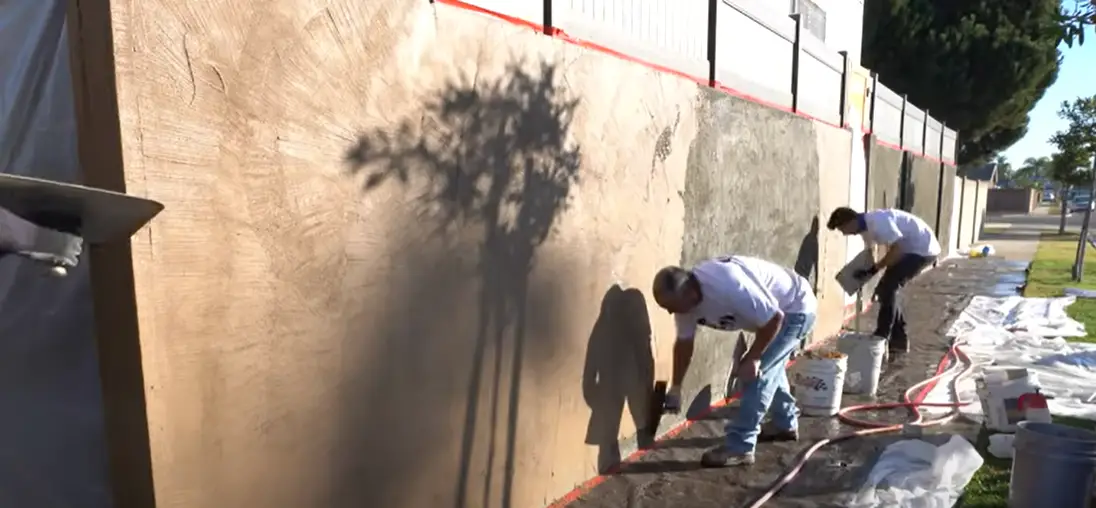
If you are considering stucco for your exterior cinder block walls, there are a few things to keep in mind. First, stucco needs to be applied over a wire mesh or metal lath to provide support and prevent cracking. Second, stucco should be applied in two or three coats, with each coat allowed to dry before the next is applied. Finally, you will need to choose a finish for your stucco. A smooth finish is the most popular choice, but you can also choose a textured finish for a more unique look.[1]
Vinyl Siding
One popular way to cover exterior cinder block walls is by installing vinyl siding. Vinyl siding is a type of plastic siding that is installed in sheets and comes in a variety of colors and styles. It is a popular choice for covering exterior cinder block walls because it is relatively inexpensive, easy to install, and requires little maintenance.
If you decide that vinyl siding is the right choice for your cinder block wall, there are a few things you will need in order to get started. First, you will need to measure the wall so you know how much siding to purchase. Second, you will need to purchase trim and flashing to finish off the edges of the siding. Finally, you will need to rent or purchase a power washer in order to clean the cinder block wall before installing the vinyl siding.[1]
Artificial Stone
One popular way to cover cinder block walls is with artificial stone veneer. This type of veneer is made from a lightweight concrete mix and molded into realistic-looking stones. It’s then attached to the wall with mortar or an adhesive.
Artificial stone veneer is a great option if you want the look of real stone without the weight or cost. It comes in a variety of colors and styles, so you can find an option that fits your home’s style.[1]
Climbing Plants
One of the most common ways to cover an exterior cinder block wall is to plant climbers. This is a great option if you want to add some color and life to your wall. Climbing plants can also help create privacy or camouflage unsightly features.

There are many different types of climbing plants, so it’s important to choose one that will suit your needs. If you want something fast-growing, consider ivy or bougainvillea. If you’re looking for a plant that doesn’t require much maintenance, try Boston ferns or pothos vines. And if you want a plant that blooms flowers, opt for clematis or jasmine.[1]
Paint
One popular way to cover exterior cinder block walls is by painting them. This option can be very inexpensive, depending on the type and quality of paint you use. It is also a fairly easy process, although it may require some prep work beforehand.
Once the surface is prepped and ready to go, you can start painting! Be sure to use a high-quality exterior paint that is designed for use on masonry surfaces. If you are unsure of what kind to use, ask a professional at your local hardware store.
Applying paint to cinder block walls can be done with a brush, roller, or even a sprayer. If you are using a brush or roller, be sure to start with an exterior primer before applying the paint itself. This will help the paint adhere better and last longer.[4]
Pallet Wood Covering
One popular way to cover exterior cinder block walls is by using pallet wood. This method is relatively easy and does not require many tools or materials. Plus, it gives your wall a rustic look that can add character to your home.
To cover your wall with pallet wood, you will need:
- pallets (enough to cover the entire wall)
- a saw
- nails or screws
- a drill
- paint or stain (optional)
First, cut the pallets into pieces that are the same length. You will then need to nail or screw the pieces of wood onto the wall. Make sure that the boards are flush against each other so that there are no gaps.
Once the boards are in place, you can paint or stain them if you would like. This step is entirely optional and is up to you.[4]
Shiplap
Shiplap siding is a great way to cover exterior cinder block walls.
Shiplap siding is a type of horizontal siding that consists of overlapping boards. Shiplap siding can give your home a rustic or cottage look and feel. It’s also a great way to cover up any imperfections in your cinder block walls.[4]

Wood Panel
One popular way to cover exterior cinder block walls is by using wood panels. Wood paneling is relatively easy to install and can be done as a do-it-yourself project. There are a few things to keep in mind when installing wood paneling:
- Make sure the panels are properly sealed and primed before installation.
- Install a vapor barrier behind the panels to prevent moisture damage.
- Use screws or nails that are long enough to penetrate the studs in the wall.
If you’re looking for a more traditional look, tongue and groove boards are a great option. Tongue and groove boards come in various thicknesses and woods, so you can find an option that fits your budget and style. Keep in mind that tongue and groove boards need to be installed over a solid substrate, so you may need to add plywood or OSB behind the boards before installation.
If you want a more rustic look, consider using reclaimed wood panels. Reclaimed wood has a unique patina and character that can’t be replicated with new wood. Keep in mind that reclaimed wood can be more difficult to work with because it is often warped or cupped. You’ll also need to make sure the panels are properly sealed and primed before installation.[4]
Drywall
One of the most popular ways to cover exterior cinder block walls is by installing drywall. Drywall is a type of wallboard that is made out of gypsum and paper. It is lightweight, fire-resistant, and easy to install.
The first step in installing drywall is to measure the dimensions of the wall and then cut the drywall sheets to size. Next, use screws or nails to attach the drywall sheets to the studs on the cinder block wall. Once all of the sheets are in place, apply joint compound to all of the seams and nail/screw heads. Allow the joint compound to dry and then sand it smooth. Finally, paint or texture as desired.[4]
How To Cover Cinder Block Basement Walls
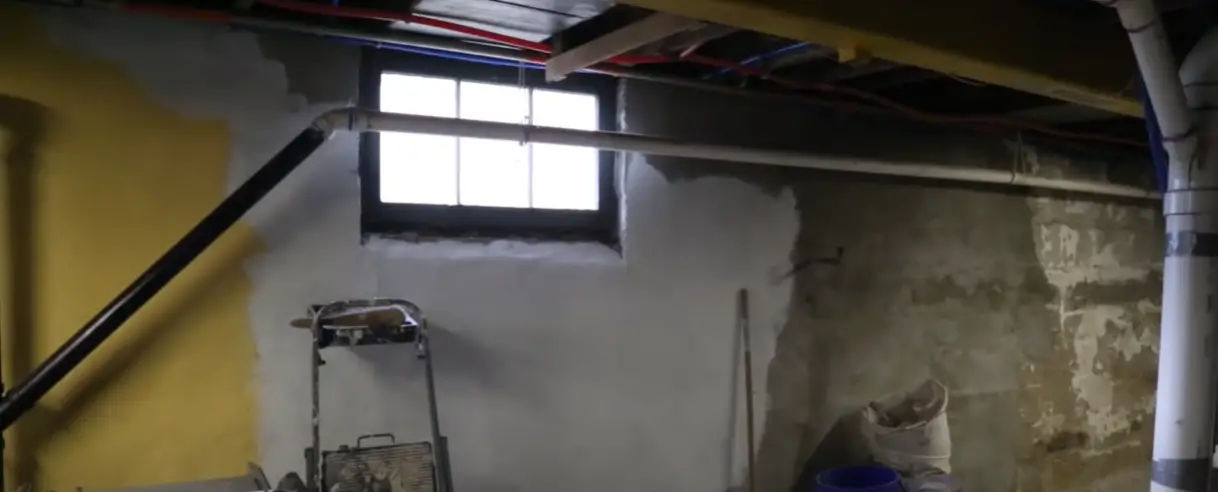
Begin With Deep Cleaning
Before you start painting or sealing your cinder block walls, it’s important to give them a good cleaning. If your cinder blocks are particularly dirty, you may need to power wash them first. Be sure to let the blocks completely dry before starting any type of treatment.
Once they’re clean, you can fill in any cracks or holes with concrete patch or mortar mix. You’ll also want to use a brush or roller to apply a masonry primer to the entire surface. This will help the paint or sealer adhere better and create a more uniform appearance.[3]
Repair holes and cracks
The first step is to repair any holes or cracks in the cinder block wall. You can do this by filling the holes with mortar or concrete. Once the filler has dried, you can sand it down so that it is flush with the rest of the wall.
Consider waterproofing your basement walls
One of the best ways to cover exterior cinder block walls is by waterproofing your basement walls. This will not only improve the look of your home but will also protect it from moisture damage. There are a number of different ways to waterproof your basement walls, so be sure to do some research and find the best option for your home.[3]
Decide if you should insulate your basement walls or not
If you live in a cold climate, insulating your basement walls is a no-brainer. Not only will it keep your basement warmer, but it will also help reduce your energy bills. Even if you don’t live in a cold climate, though, insulation can still be a good idea. If your basement is unheated or only heated sporadically, insulation will help keep the temperature more consistent.
There are two main types of insulation for exterior walls: rigid foam and fiberglass batts. Rigid foam is more expensive but easier to install (you simply glue or screw it to the wall), and it provides better thermal protection than fiberglass batts. Fiberglass batts are less expensive but more difficult to install, and they don’t provide as much thermal protection.[3]
Choose the right materials or wall covering
Cinder block is a very versatile building material and can be used for both interior and exterior walls. When choosing the right materials or wall coverings for your exterior cinder block walls, there are several things to consider. The first is the climate. If you live in an area with extreme weather conditions, you will need to choose materials that can withstand the elements. For example, if you live in an area with high winds, you will want to avoid materials that are susceptible to wind damage.
Another thing to consider is the amount of sunlight exposure your exterior cinder block walls will receive. If they will be regularly exposed to direct sunlight, you will want to choose materials that won’t fade or discolor over time.
Finally, you will also want to consider the overall aesthetic you are trying to achieve. There are many different types of materials and wall coverings available that can help you create the perfect look for your home.[3]
Enhancing Exterior Cinder Block Walls: Creative Covering Options
Exterior cinder block walls can be transformed to improve aesthetics and functionality. Below, we explore various creative options for covering exterior cinder block walls, discussing their benefits, considerations, and installation methods to help you decide on the best approach for enhancing the appearance of your outdoor spaces.
| Option | Information |
|---|---|
| Stucco | Applying stucco offers a smooth, durable, and weather-resistant finish that can be customized with colors and textures. |
| Veneer Stone | Veneer stone panels provide a realistic stone look, adding texture and charm to cinder block walls. |
| Vertical Gardens | Creating vertical gardens with climbing plants or modular planting systems can add greenery and soften the wall’s appearance. |
| Wood Panels | Wood panels or slats can add warmth and a contemporary look to cinder block walls. |
| Brick Veneer | Applying brick veneer offers the appearance of a traditional brick wall without the weight and complexity of full bricks. |
| Paint | Painting cinder block walls with suitable masonry paint can instantly refresh their appearance and add color. |
| Climbing Plants | Climbing plants can be trained to cover the wall, creating a natural and vibrant look. |
| Outdoor Art | Adding murals or outdoor art installations can transform the wall into a unique and eye-catching feature. |
| Tile or Mosaic | Tiling the wall or creating a mosaic can introduce intricate patterns and visual interest. |
| Outdoor Curtains | Installing outdoor curtains can add a touch of elegance while offering privacy and shade. |
Explanation of the Table:
- Option: Describes different creative covering options for exterior cinder block walls.
- Information: Provides an overview of each option’s characteristics and benefits.
By considering these creative covering options for exterior cinder block walls, you can select the solution that aligns with your design preferences and outdoor space needs.
FAQ
How do you spruce a cinder block wall?
By painting it, you can give your cinder block wall a fresh look that will last for years. You can also consider adding wallpaper or paneling to give the wall more interest and personality. If you want a more permanent solution, you can install stone veneer or stucco over the cinder block wall.
How can I cover my concrete walls cheaply?
One of the most common questions we get asked is how to cover exterior cinder block walls cheaply. While there are a few different ways to do this, one of the most popular methods is using a product called “concrete bonding agent.” This type of product can be found at most hardware stores and will help to create a smooth surface for your paint or other coating. Once you have applied the bonding agent, you can then choose any color paint or sealant that you would like!
How do you make a concrete wall look good?
You may be wondering how to cover exterior cinder block walls to make them look good. There are a few different ways that you can go about this. You can either paint the blocks or install siding over them.
Can you put siding over the cinder block?
Yes, you can put siding over the cinder block. However, there are a few things to keep in mind before doing so. First, make sure that the surface of the cinder block is smooth and even. If not, you may need to apply a layer of mortar or stucco before attaching the siding. Second, be sure to use screws or nails that are long enough to penetrate through the siding and into the cinder block behind it. Finally, make sure that your chosen siding is compatible with the climate in your area. Certain types of siding may not stand up well to extreme heat or cold.
How do you cover rough concrete walls?
The best way to cover rough concrete walls is with a textured coating or paneling system. There are a variety of products on the market that can be used, including stucco, stone veneer, and brick veneer.
If you want to add some extra insulation to your home, you can opt for a foam-backed product. These products will not only give your home an extra layer of protection against the elements but will also help keep noise levels down.
What are the benefits of covering exterior cinder block walls?
Covering exterior cinder block walls can improve insulation, enhance the appearance of the building, protect against weathering, and increase energy efficiency by reducing heat loss.
What are the different options for covering exterior cinder block walls?
There are several options to cover exterior cinder block walls, including stucco, stone veneer, brick veneer, wood cladding, vinyl siding, and cementitious panels. Each option offers a unique look and benefits.
Can you use paint to cover cinder block walls?
Yes, painting is a viable option to cover cinder block walls. Masonry paint or elastomeric paint can be applied to create a new look and provide a layer of protection against the elements. Make sure the surface is properly prepared before painting.
Is it possible to add insulation while covering cinder block walls?
Yes, when covering cinder block walls, you can incorporate insulation to improve energy efficiency. This can be done by attaching insulation panels to the wall before applying the chosen covering material.
What is the process for applying stucco to cinder block walls?
To apply stucco to cinder block walls, you’ll need to clean the surface, apply a bonding agent, mix and apply the stucco mixture, and then finish it with a trowel to achieve the desired texture. The process requires some skill and experience to achieve a smooth and even finish.
Can wood cladding be used to cover cinder block walls?
Yes, wood cladding can be used to cover cinder block walls, adding a warm and natural aesthetic to the exterior. It’s important to create a moisture barrier between the wood and the cinder block to prevent water damage and rot.
What is stone veneer, and how is it installed on cinder block walls?
Stone veneer is a thin layer of real or manufactured stone that is applied to the surface of a wall. It’s installed using mortar or adhesive, creating the appearance of a solid stone wall without the weight and cost of full stone construction.
Can you install brick veneer over cinder block walls?
Yes, brick veneer can be installed over cinder block walls to achieve the look of a traditional brick wall. This involves attaching thin brick tiles or panels to the cinder block using mortar or adhesive.
Is it possible to combine different covering materials on cinder block walls?
Yes, you can combine different covering materials on cinder block walls to create a unique and visually appealing look. However, proper installation techniques and compatibility of materials should be considered to ensure the longevity and effectiveness of the covering.
Should I hire a professional to cover my exterior cinder block walls?
Hiring a professional for covering exterior cinder block walls is recommended, especially if you’re not experienced in construction or masonry work. Professionals can ensure proper installation, provide advice on suitable materials, and achieve the desired finish.
Conclusion
We hope you found this article helpful! If you have any questions or tips of your own, be sure to leave them in the comments below. And remember, when it comes to covering exterior cinder block walls, there is no one-size-fits-all solution – so experiment and find what works best for you and your home. Thanks for reading!
References
- https://www.homereference.net/cover-exterior-cinder-block-walls/#
- https://homeguides.sfgate.com/cheap-way-disguise-cinder-block-wall-24614.html
- https://basementing.com/how-to-cover-cinder-block-basement-walls/
- https://homebuilding.thefuntimesguide.com/how_to_cover_cinder_block_wall/


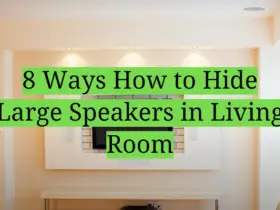


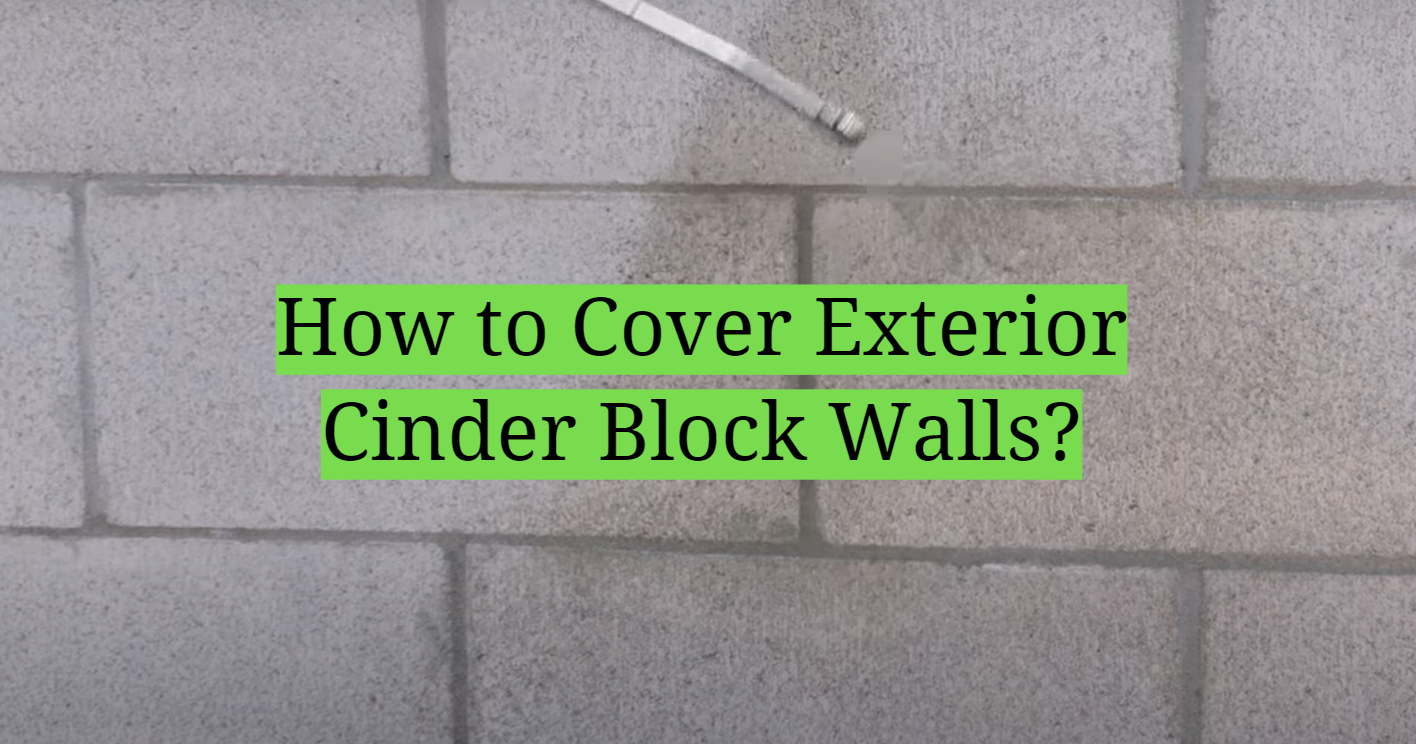
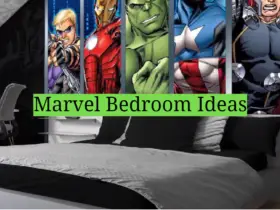





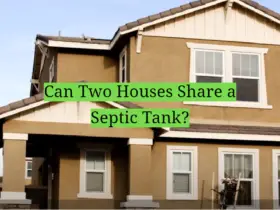

When we moved into our new house last year, it had bare cinder block walls on the exterior. They were such an eyesore! I did a lot of research on the best ways to cover them up and make them more attractive. We ended up going with a faux stone veneer – it has the look of real stone but is much more lightweight and affordable. The transformation was amazing! Now our house looks like it’s made of stone rather than cinder blocks. The veneer panels were easy to install with construction adhesive. This is a great option if you want a natural stone look.
I’ve always disliked the look of bare cinder block on the outside of homes, so when we built our place, I knew we had to cover the blocks somehow. We opted to stucco the exterior walls using a acrylic-based product. It gave a nice, smooth, consistent finish over the blocks. The stucco held up well over the years too. Just make sure to properly seal and prepare the blocks first before applying the stucco. Overall, a great way to hide blocks and make it look like you have standard exterior walls.
When our family expanded, we converted our detached garage into a guest suite. Problem was, the exterior walls were bare concrete blocks – not exactly inviting or attractive! We looked at siding, but it was too expensive. Ultimately, we went with a textured spray-on coating that gave the blocks a stucco-like finish. Much more aesthetically pleasing! The coating was affordable and durable too. As long as the blocks are prepped properly, I’d highly recommended this as an easy solution for covering blocks.
Soon after moving in, I grew tired of looking at the bland concrete block walls surrounding our backyard. I researched inexpensive options to cover them up and landed on exterior insulation finishing systems (EIFS). Essentially, foam insulation boards are adhered to the blocks, then covered in a textured acrylic stucco. This gave the walls a completely refreshed, uniform look. Best of all, it provided insulation. The only downside is you have to be careful not to damage the covering. Overall though, EIFS was a budget-friendly way to get a new exterior.
When we bought our cottage on the lake, it had horrible concrete block walls that clearly were an eyesore. We wanted to cover them but avoid expensive siding. My dad actually recommended using spaced wood boards affixed right over the blocks. We stained the boards a deep brown and it gave the look of an upscale cottage! Who knew a simple wood wall would make such a difference. The spacing between boards helps with drainage too. Really an inexpensive but transformative way to cover those unsightly blocks. I recommend it.
Soon after moving into our place, I disliked looking out at the ugly cinder block retaining wall in our backyard. I didn’t want to tear it down and rebuild, so I needed an affordable way to cover it up. After researching different options, I settled on fastening panels of cedar boards to the blocks using masonry screws. The cedar offered an attractive, natural look that completely hid the cinder blocks. Just make sure to seal the cedar annually. This was an easy DIY project that made a huge impact. Our wall looks like a high-end cedar fence now. A great way to transform block on a budget.
When we converted our garage into a living space, we were left with unattractive bare cinder block walls. We weighed our options – siding was too pricey and stucco seemed like too much work. Ultimately, we went with an exterior textured paint coating that mimics stucco. After properly cleaning and sealing the blocks, we rolled on two coats of the thick, textured acrylic paint. It adhered nicely and left a stucco-like look when dry. The entire project only cost us about $500 in supplies. I’d recommend this option if you’re handy and want an affordable way to mimic stucco. Our walls look completely transformed.
I’ll be honest, I was pretty overwhelmed when I started researching how to cover the concrete block walls on our home’s exterior. There are so many options out there ranging from siding to stucco. In the end, I settled on a process called Direct-Applied Exterior Finish System (DEFS). It involved priming the blocks, then applying an acrylic-modified base coat, embedding fiberglass mesh, applying a second acrylic-modified coat, and finally applying an acrylic-based textured finish coat. It was a bit labor intensive but mimicked a classic stucco finish beautifully. For those willing to put in the work, DEFS provides a durable and attractive covering.
When we bought our 1970s house, one of the first things I wanted to change was the dated concrete block exterior walls. We looked into siding, but removing the blocks would be costly. My contractor suggested fastening 2-inch thick EPS foam boards directly over the blocks using adhesive, then covering the foam with a fiberglass mesh reinforced acrylic stucco finish. The foam provided insulation and allowed us to maintain the shape of the blocks under the stucco. It was a cost-effective way to update the look. Just make sure the foam boards are properly secured as the stucco finish can be heavy. Overall, a great way to cover blocks affordably.
I’ll admit, our home’s bare concrete block exterior was an eyesore. We wanted the look of brick but couldn’t afford real brick veneer. After researching faux options, I found simulated brick panels made of high-density urethane. They snap right on over existing blocks or walls. The vertical panels interlock together and are colored to look convincingly like real mortared brick. For a fraction of the cost, we were able to transform our home’s exterior into what looks like a brick facade. The panels were easy for us to install ourselves. This is absolutely the most affordable way to make blocks look like brick. I’m so pleased with how our home looks now.
When we bought our 1970s ranch house, the bare concrete block exterior walls were soured, dated and just plain ugly. We wanted a more updated, finished look but were on a tight budget. After getting quotes, traditional siding was out of our price range. Instead I came across vinyl siding specifically designed for concrete blocks. It has a taller profile that attaches right over the blocks with special fasteners. The installed cost was far less than traditional siding. It took a weekend to fully install the vinyl panels ourselves. Despite being budget-friendly, I’m amazed by how much more attractive our house looks. Vinyl siding was the perfect affordable solution for covering our block walls.
Soon after moving into our new construction home, I quickly tired of the basic gray concrete block walls that encircled our backyard. I hesitated to cover them, assuming it would be prohibitively expensive. After more research, I found that exterior parging, a technique using multiple coats of mortar-based render, was quite affordable. It required some time and elbow grease to apply the various mortar layers correctly but transformed the drab blocks into a cohesive, plaster-like wall. For a few hundred dollars in supplies and some sweat equity, our backyard is now defined by attractive rendered walls rather than ugly blocks. Exterior parging is absolutely a budget-friendly option for dramatically improving the look of concrete block walls.